Analyzing HR Practices: Cultural Context and International Variations
VerifiedAdded on 2020/03/02
|8
|1976
|173
Essay
AI Summary
This essay delves into the complexities of international human resource management, emphasizing how cultural contexts significantly influence HR practices. The introduction highlights the crucial role of HR departments in organizational growth and employee management, setting the stage for an exploration of how cultural differences impact standard HR procedures. The essay uses performance appraisal and recruitment and selection as case studies, discussing challenges like leniency errors in performance evaluations due to cultural nuances, and the application of Hofstede's cultural dimensions to recruitment. Examples from countries like the US, UK, China, and Japan illustrate these differences. The essay concludes by recommending that organizations train personnel globally and recognize cultural differences to adapt HR practices effectively. The essay underscores the importance of culturally sensitive approaches to achieve consistent and fair outcomes in international HR.
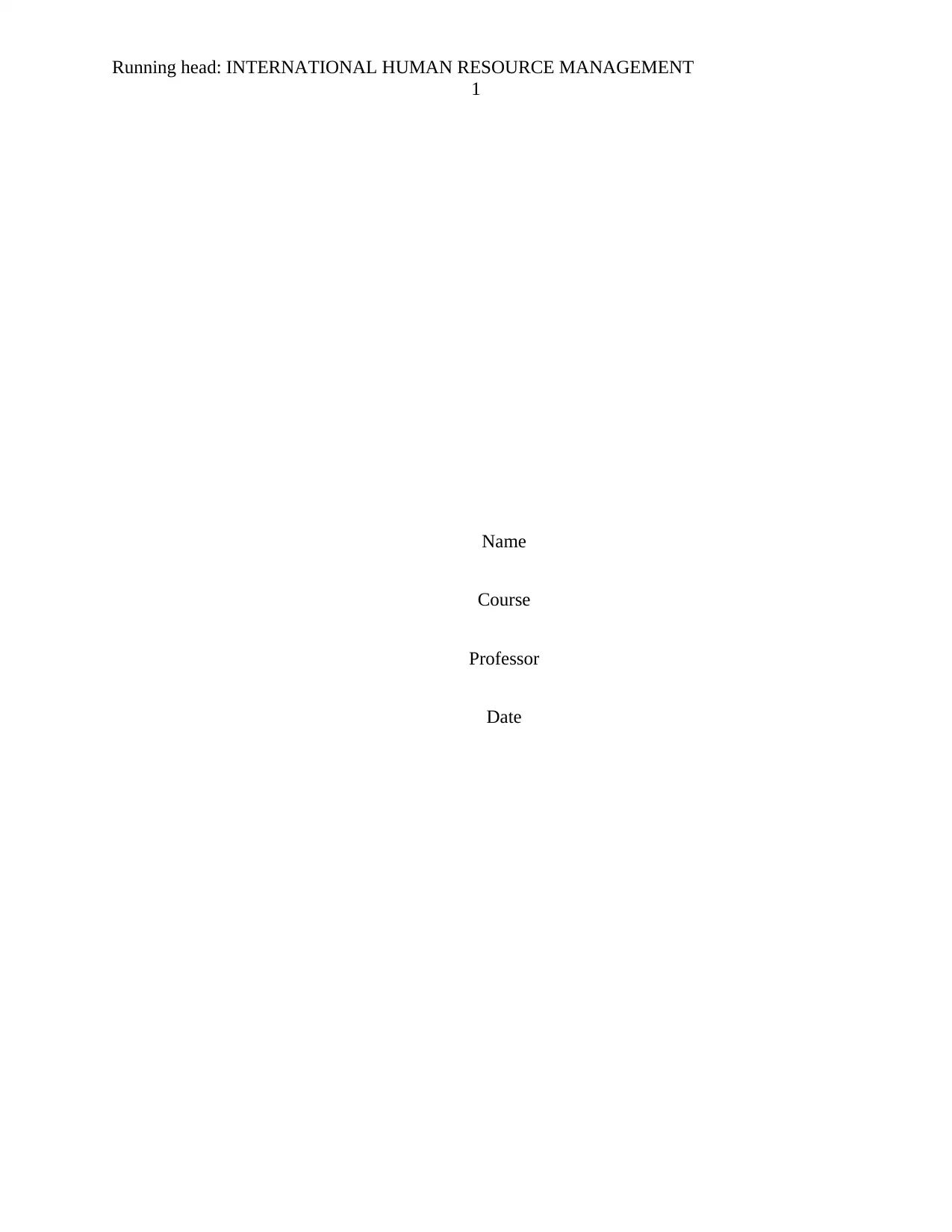
Running head: INTERNATIONAL HUMAN RESOURCE MANAGEMENT
1
Name
Course
Professor
Date
1
Name
Course
Professor
Date
Paraphrase This Document
Need a fresh take? Get an instant paraphrase of this document with our AI Paraphraser
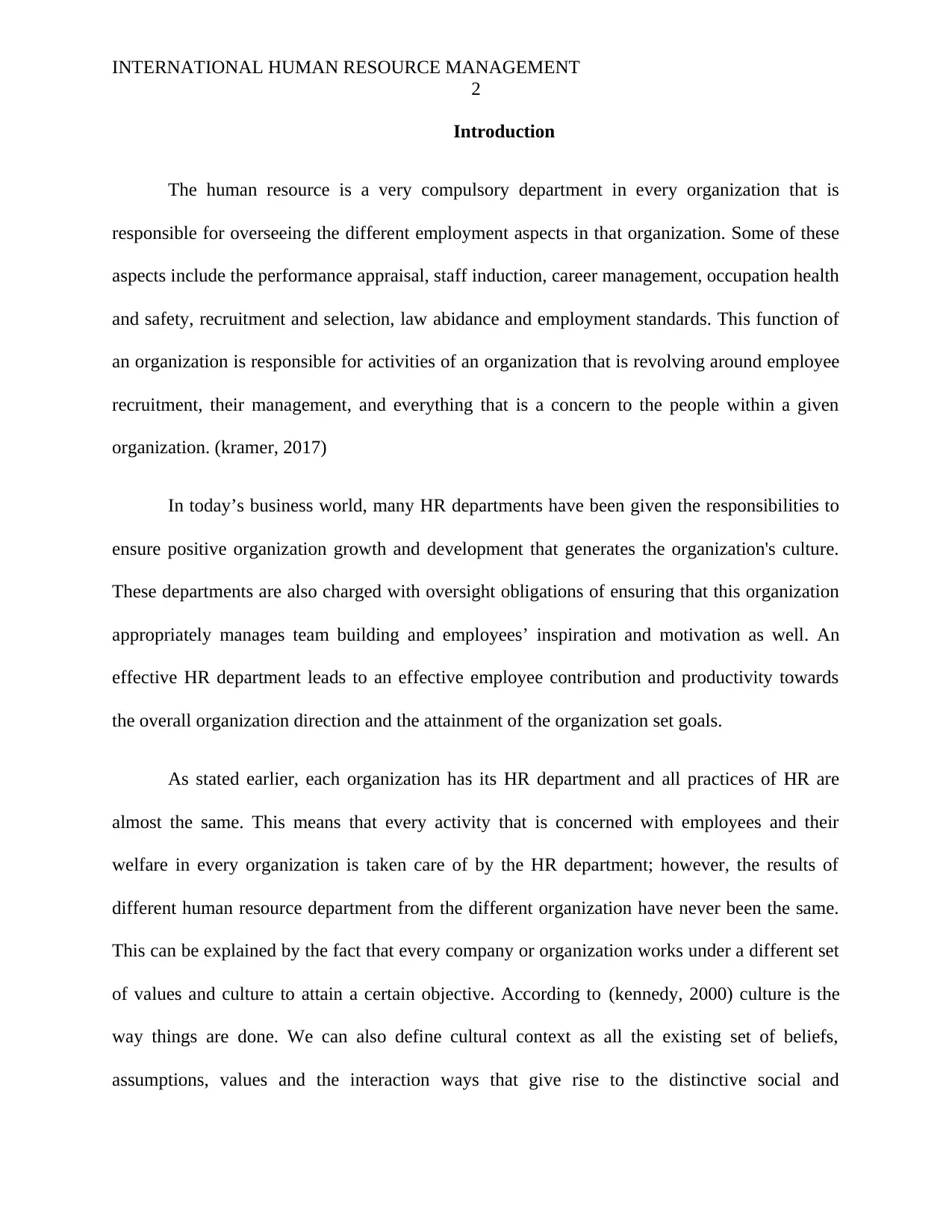
INTERNATIONAL HUMAN RESOURCE MANAGEMENT
2
Introduction
The human resource is a very compulsory department in every organization that is
responsible for overseeing the different employment aspects in that organization. Some of these
aspects include the performance appraisal, staff induction, career management, occupation health
and safety, recruitment and selection, law abidance and employment standards. This function of
an organization is responsible for activities of an organization that is revolving around employee
recruitment, their management, and everything that is a concern to the people within a given
organization. (kramer, 2017)
In today’s business world, many HR departments have been given the responsibilities to
ensure positive organization growth and development that generates the organization's culture.
These departments are also charged with oversight obligations of ensuring that this organization
appropriately manages team building and employees’ inspiration and motivation as well. An
effective HR department leads to an effective employee contribution and productivity towards
the overall organization direction and the attainment of the organization set goals.
As stated earlier, each organization has its HR department and all practices of HR are
almost the same. This means that every activity that is concerned with employees and their
welfare in every organization is taken care of by the HR department; however, the results of
different human resource department from the different organization have never been the same.
This can be explained by the fact that every company or organization works under a different set
of values and culture to attain a certain objective. According to (kennedy, 2000) culture is the
way things are done. We can also define cultural context as all the existing set of beliefs,
assumptions, values and the interaction ways that give rise to the distinctive social and
2
Introduction
The human resource is a very compulsory department in every organization that is
responsible for overseeing the different employment aspects in that organization. Some of these
aspects include the performance appraisal, staff induction, career management, occupation health
and safety, recruitment and selection, law abidance and employment standards. This function of
an organization is responsible for activities of an organization that is revolving around employee
recruitment, their management, and everything that is a concern to the people within a given
organization. (kramer, 2017)
In today’s business world, many HR departments have been given the responsibilities to
ensure positive organization growth and development that generates the organization's culture.
These departments are also charged with oversight obligations of ensuring that this organization
appropriately manages team building and employees’ inspiration and motivation as well. An
effective HR department leads to an effective employee contribution and productivity towards
the overall organization direction and the attainment of the organization set goals.
As stated earlier, each organization has its HR department and all practices of HR are
almost the same. This means that every activity that is concerned with employees and their
welfare in every organization is taken care of by the HR department; however, the results of
different human resource department from the different organization have never been the same.
This can be explained by the fact that every company or organization works under a different set
of values and culture to attain a certain objective. According to (kennedy, 2000) culture is the
way things are done. We can also define cultural context as all the existing set of beliefs,
assumptions, values and the interaction ways that give rise to the distinctive social and
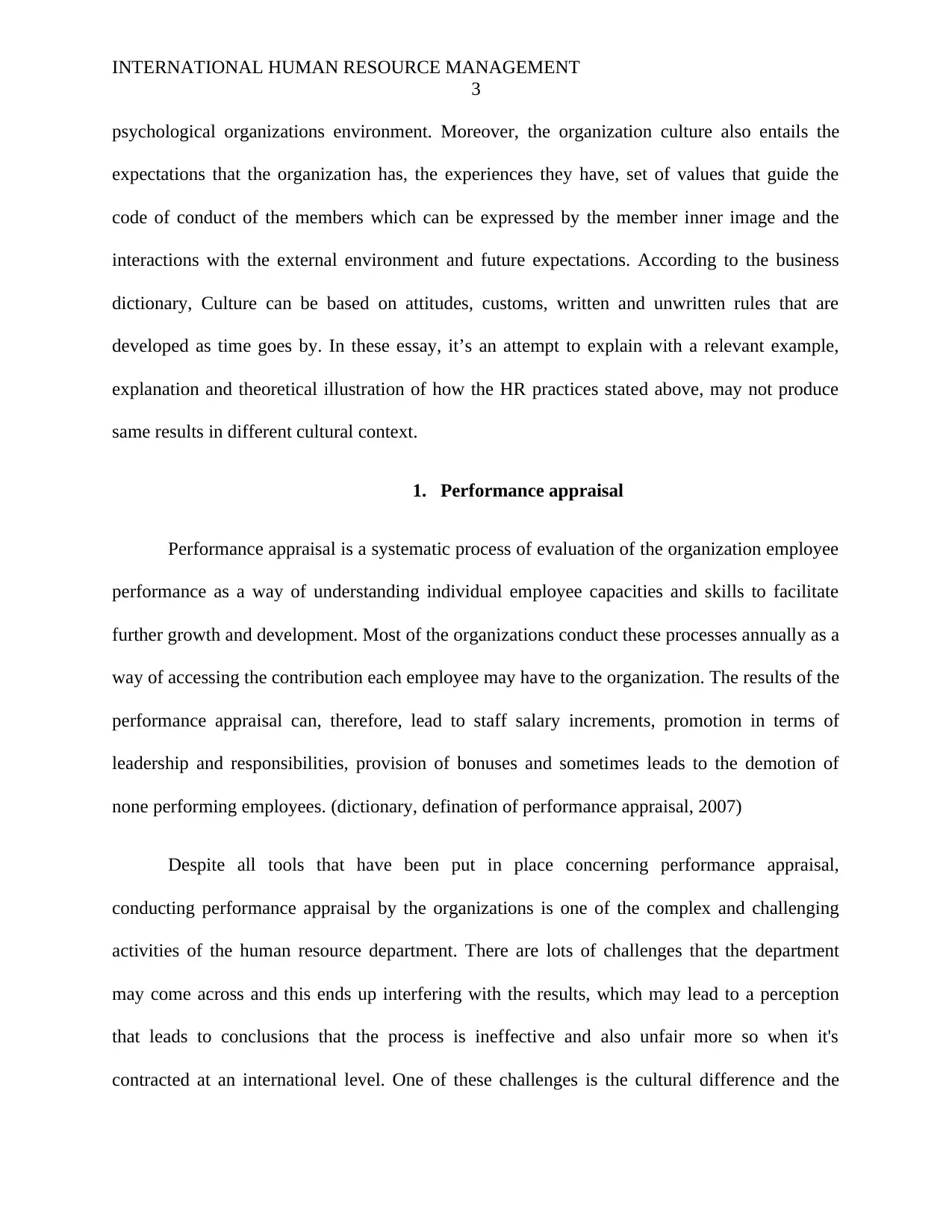
INTERNATIONAL HUMAN RESOURCE MANAGEMENT
3
psychological organizations environment. Moreover, the organization culture also entails the
expectations that the organization has, the experiences they have, set of values that guide the
code of conduct of the members which can be expressed by the member inner image and the
interactions with the external environment and future expectations. According to the business
dictionary, Culture can be based on attitudes, customs, written and unwritten rules that are
developed as time goes by. In these essay, it’s an attempt to explain with a relevant example,
explanation and theoretical illustration of how the HR practices stated above, may not produce
same results in different cultural context.
1. Performance appraisal
Performance appraisal is a systematic process of evaluation of the organization employee
performance as a way of understanding individual employee capacities and skills to facilitate
further growth and development. Most of the organizations conduct these processes annually as a
way of accessing the contribution each employee may have to the organization. The results of the
performance appraisal can, therefore, lead to staff salary increments, promotion in terms of
leadership and responsibilities, provision of bonuses and sometimes leads to the demotion of
none performing employees. (dictionary, defination of performance appraisal, 2007)
Despite all tools that have been put in place concerning performance appraisal,
conducting performance appraisal by the organizations is one of the complex and challenging
activities of the human resource department. There are lots of challenges that the department
may come across and this ends up interfering with the results, which may lead to a perception
that leads to conclusions that the process is ineffective and also unfair more so when it's
contracted at an international level. One of these challenges is the cultural difference and the
3
psychological organizations environment. Moreover, the organization culture also entails the
expectations that the organization has, the experiences they have, set of values that guide the
code of conduct of the members which can be expressed by the member inner image and the
interactions with the external environment and future expectations. According to the business
dictionary, Culture can be based on attitudes, customs, written and unwritten rules that are
developed as time goes by. In these essay, it’s an attempt to explain with a relevant example,
explanation and theoretical illustration of how the HR practices stated above, may not produce
same results in different cultural context.
1. Performance appraisal
Performance appraisal is a systematic process of evaluation of the organization employee
performance as a way of understanding individual employee capacities and skills to facilitate
further growth and development. Most of the organizations conduct these processes annually as a
way of accessing the contribution each employee may have to the organization. The results of the
performance appraisal can, therefore, lead to staff salary increments, promotion in terms of
leadership and responsibilities, provision of bonuses and sometimes leads to the demotion of
none performing employees. (dictionary, defination of performance appraisal, 2007)
Despite all tools that have been put in place concerning performance appraisal,
conducting performance appraisal by the organizations is one of the complex and challenging
activities of the human resource department. There are lots of challenges that the department
may come across and this ends up interfering with the results, which may lead to a perception
that leads to conclusions that the process is ineffective and also unfair more so when it's
contracted at an international level. One of these challenges is the cultural difference and the
⊘ This is a preview!⊘
Do you want full access?
Subscribe today to unlock all pages.

Trusted by 1+ million students worldwide
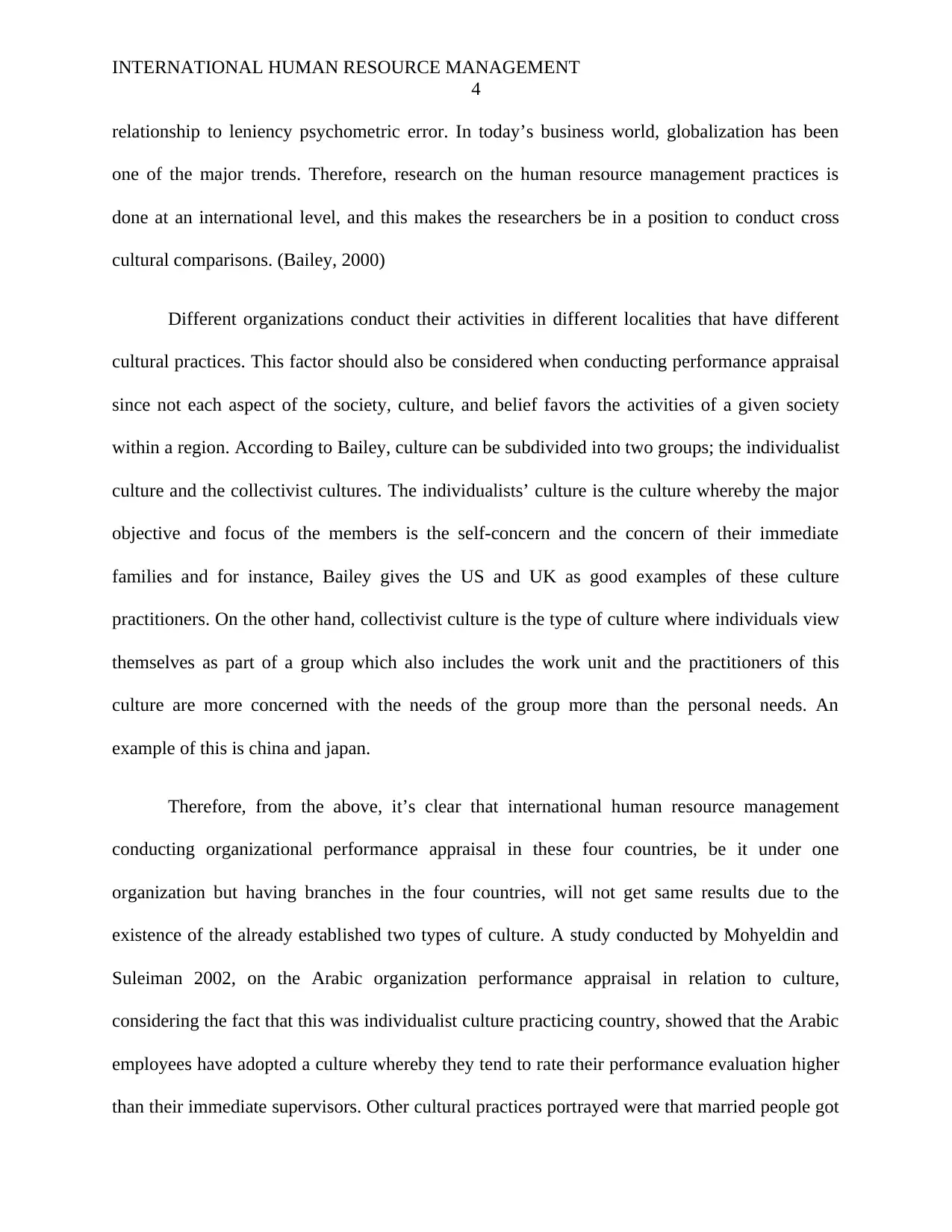
INTERNATIONAL HUMAN RESOURCE MANAGEMENT
4
relationship to leniency psychometric error. In today’s business world, globalization has been
one of the major trends. Therefore, research on the human resource management practices is
done at an international level, and this makes the researchers be in a position to conduct cross
cultural comparisons. (Bailey, 2000)
Different organizations conduct their activities in different localities that have different
cultural practices. This factor should also be considered when conducting performance appraisal
since not each aspect of the society, culture, and belief favors the activities of a given society
within a region. According to Bailey, culture can be subdivided into two groups; the individualist
culture and the collectivist cultures. The individualists’ culture is the culture whereby the major
objective and focus of the members is the self-concern and the concern of their immediate
families and for instance, Bailey gives the US and UK as good examples of these culture
practitioners. On the other hand, collectivist culture is the type of culture where individuals view
themselves as part of a group which also includes the work unit and the practitioners of this
culture are more concerned with the needs of the group more than the personal needs. An
example of this is china and japan.
Therefore, from the above, it’s clear that international human resource management
conducting organizational performance appraisal in these four countries, be it under one
organization but having branches in the four countries, will not get same results due to the
existence of the already established two types of culture. A study conducted by Mohyeldin and
Suleiman 2002, on the Arabic organization performance appraisal in relation to culture,
considering the fact that this was individualist culture practicing country, showed that the Arabic
employees have adopted a culture whereby they tend to rate their performance evaluation higher
than their immediate supervisors. Other cultural practices portrayed were that married people got
4
relationship to leniency psychometric error. In today’s business world, globalization has been
one of the major trends. Therefore, research on the human resource management practices is
done at an international level, and this makes the researchers be in a position to conduct cross
cultural comparisons. (Bailey, 2000)
Different organizations conduct their activities in different localities that have different
cultural practices. This factor should also be considered when conducting performance appraisal
since not each aspect of the society, culture, and belief favors the activities of a given society
within a region. According to Bailey, culture can be subdivided into two groups; the individualist
culture and the collectivist cultures. The individualists’ culture is the culture whereby the major
objective and focus of the members is the self-concern and the concern of their immediate
families and for instance, Bailey gives the US and UK as good examples of these culture
practitioners. On the other hand, collectivist culture is the type of culture where individuals view
themselves as part of a group which also includes the work unit and the practitioners of this
culture are more concerned with the needs of the group more than the personal needs. An
example of this is china and japan.
Therefore, from the above, it’s clear that international human resource management
conducting organizational performance appraisal in these four countries, be it under one
organization but having branches in the four countries, will not get same results due to the
existence of the already established two types of culture. A study conducted by Mohyeldin and
Suleiman 2002, on the Arabic organization performance appraisal in relation to culture,
considering the fact that this was individualist culture practicing country, showed that the Arabic
employees have adopted a culture whereby they tend to rate their performance evaluation higher
than their immediate supervisors. Other cultural practices portrayed were that married people got
Paraphrase This Document
Need a fresh take? Get an instant paraphrase of this document with our AI Paraphraser
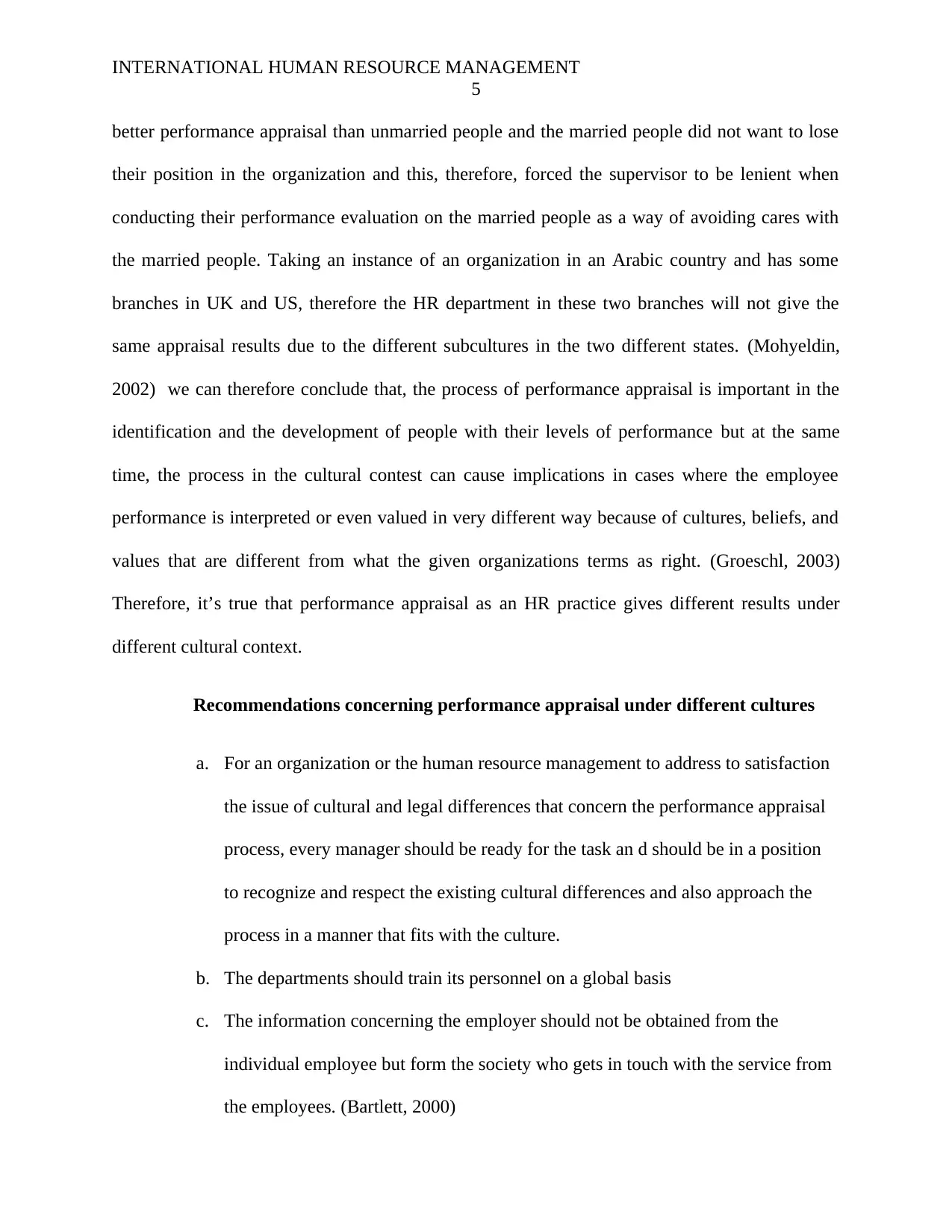
INTERNATIONAL HUMAN RESOURCE MANAGEMENT
5
better performance appraisal than unmarried people and the married people did not want to lose
their position in the organization and this, therefore, forced the supervisor to be lenient when
conducting their performance evaluation on the married people as a way of avoiding cares with
the married people. Taking an instance of an organization in an Arabic country and has some
branches in UK and US, therefore the HR department in these two branches will not give the
same appraisal results due to the different subcultures in the two different states. (Mohyeldin,
2002) we can therefore conclude that, the process of performance appraisal is important in the
identification and the development of people with their levels of performance but at the same
time, the process in the cultural contest can cause implications in cases where the employee
performance is interpreted or even valued in very different way because of cultures, beliefs, and
values that are different from what the given organizations terms as right. (Groeschl, 2003)
Therefore, it’s true that performance appraisal as an HR practice gives different results under
different cultural context.
Recommendations concerning performance appraisal under different cultures
a. For an organization or the human resource management to address to satisfaction
the issue of cultural and legal differences that concern the performance appraisal
process, every manager should be ready for the task an d should be in a position
to recognize and respect the existing cultural differences and also approach the
process in a manner that fits with the culture.
b. The departments should train its personnel on a global basis
c. The information concerning the employer should not be obtained from the
individual employee but form the society who gets in touch with the service from
the employees. (Bartlett, 2000)
5
better performance appraisal than unmarried people and the married people did not want to lose
their position in the organization and this, therefore, forced the supervisor to be lenient when
conducting their performance evaluation on the married people as a way of avoiding cares with
the married people. Taking an instance of an organization in an Arabic country and has some
branches in UK and US, therefore the HR department in these two branches will not give the
same appraisal results due to the different subcultures in the two different states. (Mohyeldin,
2002) we can therefore conclude that, the process of performance appraisal is important in the
identification and the development of people with their levels of performance but at the same
time, the process in the cultural contest can cause implications in cases where the employee
performance is interpreted or even valued in very different way because of cultures, beliefs, and
values that are different from what the given organizations terms as right. (Groeschl, 2003)
Therefore, it’s true that performance appraisal as an HR practice gives different results under
different cultural context.
Recommendations concerning performance appraisal under different cultures
a. For an organization or the human resource management to address to satisfaction
the issue of cultural and legal differences that concern the performance appraisal
process, every manager should be ready for the task an d should be in a position
to recognize and respect the existing cultural differences and also approach the
process in a manner that fits with the culture.
b. The departments should train its personnel on a global basis
c. The information concerning the employer should not be obtained from the
individual employee but form the society who gets in touch with the service from
the employees. (Bartlett, 2000)
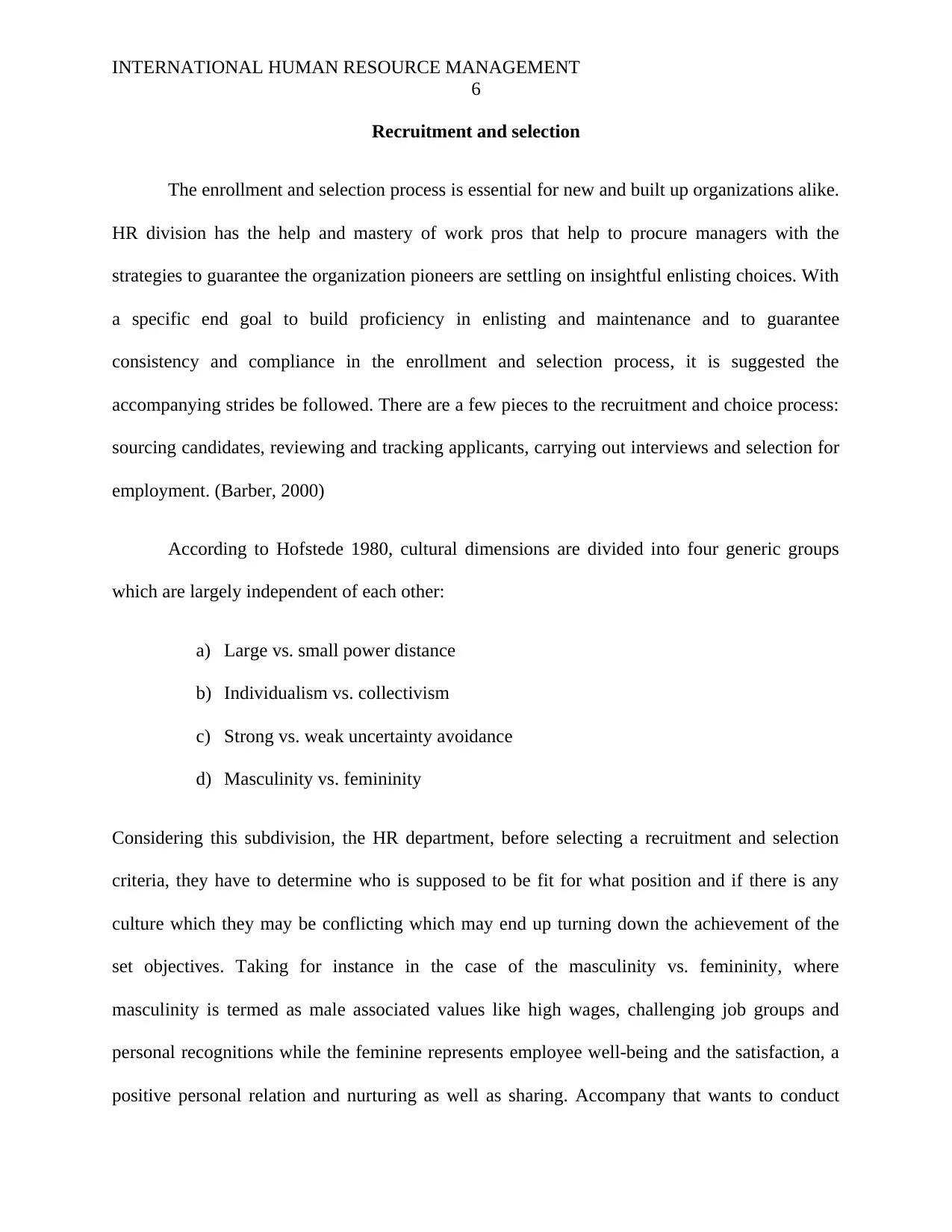
INTERNATIONAL HUMAN RESOURCE MANAGEMENT
6
Recruitment and selection
The enrollment and selection process is essential for new and built up organizations alike.
HR division has the help and mastery of work pros that help to procure managers with the
strategies to guarantee the organization pioneers are settling on insightful enlisting choices. With
a specific end goal to build proficiency in enlisting and maintenance and to guarantee
consistency and compliance in the enrollment and selection process, it is suggested the
accompanying strides be followed. There are a few pieces to the recruitment and choice process:
sourcing candidates, reviewing and tracking applicants, carrying out interviews and selection for
employment. (Barber, 2000)
According to Hofstede 1980, cultural dimensions are divided into four generic groups
which are largely independent of each other:
a) Large vs. small power distance
b) Individualism vs. collectivism
c) Strong vs. weak uncertainty avoidance
d) Masculinity vs. femininity
Considering this subdivision, the HR department, before selecting a recruitment and selection
criteria, they have to determine who is supposed to be fit for what position and if there is any
culture which they may be conflicting which may end up turning down the achievement of the
set objectives. Taking for instance in the case of the masculinity vs. femininity, where
masculinity is termed as male associated values like high wages, challenging job groups and
personal recognitions while the feminine represents employee well-being and the satisfaction, a
positive personal relation and nurturing as well as sharing. Accompany that wants to conduct
6
Recruitment and selection
The enrollment and selection process is essential for new and built up organizations alike.
HR division has the help and mastery of work pros that help to procure managers with the
strategies to guarantee the organization pioneers are settling on insightful enlisting choices. With
a specific end goal to build proficiency in enlisting and maintenance and to guarantee
consistency and compliance in the enrollment and selection process, it is suggested the
accompanying strides be followed. There are a few pieces to the recruitment and choice process:
sourcing candidates, reviewing and tracking applicants, carrying out interviews and selection for
employment. (Barber, 2000)
According to Hofstede 1980, cultural dimensions are divided into four generic groups
which are largely independent of each other:
a) Large vs. small power distance
b) Individualism vs. collectivism
c) Strong vs. weak uncertainty avoidance
d) Masculinity vs. femininity
Considering this subdivision, the HR department, before selecting a recruitment and selection
criteria, they have to determine who is supposed to be fit for what position and if there is any
culture which they may be conflicting which may end up turning down the achievement of the
set objectives. Taking for instance in the case of the masculinity vs. femininity, where
masculinity is termed as male associated values like high wages, challenging job groups and
personal recognitions while the feminine represents employee well-being and the satisfaction, a
positive personal relation and nurturing as well as sharing. Accompany that wants to conduct
⊘ This is a preview!⊘
Do you want full access?
Subscribe today to unlock all pages.

Trusted by 1+ million students worldwide
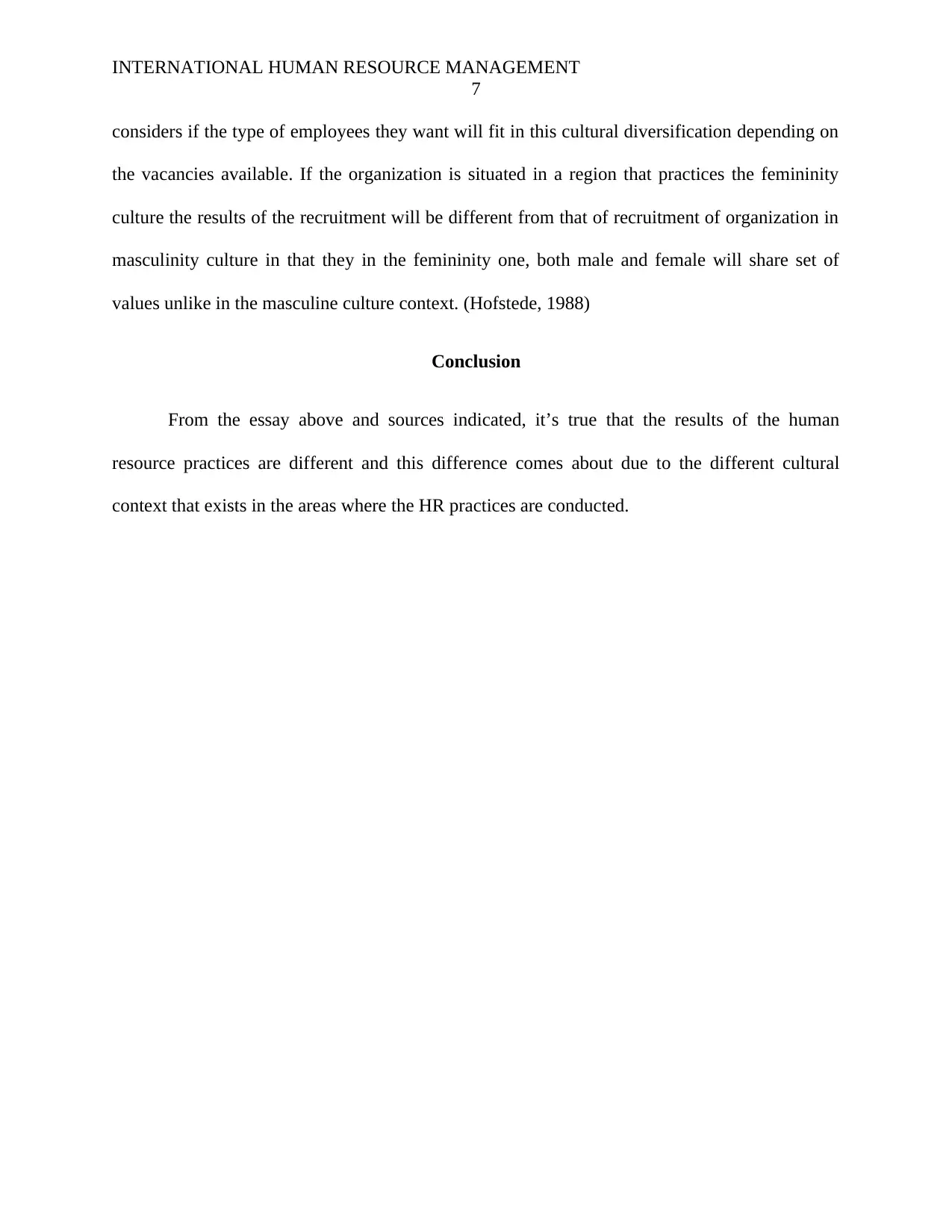
INTERNATIONAL HUMAN RESOURCE MANAGEMENT
7
considers if the type of employees they want will fit in this cultural diversification depending on
the vacancies available. If the organization is situated in a region that practices the femininity
culture the results of the recruitment will be different from that of recruitment of organization in
masculinity culture in that they in the femininity one, both male and female will share set of
values unlike in the masculine culture context. (Hofstede, 1988)
Conclusion
From the essay above and sources indicated, it’s true that the results of the human
resource practices are different and this difference comes about due to the different cultural
context that exists in the areas where the HR practices are conducted.
7
considers if the type of employees they want will fit in this cultural diversification depending on
the vacancies available. If the organization is situated in a region that practices the femininity
culture the results of the recruitment will be different from that of recruitment of organization in
masculinity culture in that they in the femininity one, both male and female will share set of
values unlike in the masculine culture context. (Hofstede, 1988)
Conclusion
From the essay above and sources indicated, it’s true that the results of the human
resource practices are different and this difference comes about due to the different cultural
context that exists in the areas where the HR practices are conducted.
Paraphrase This Document
Need a fresh take? Get an instant paraphrase of this document with our AI Paraphraser
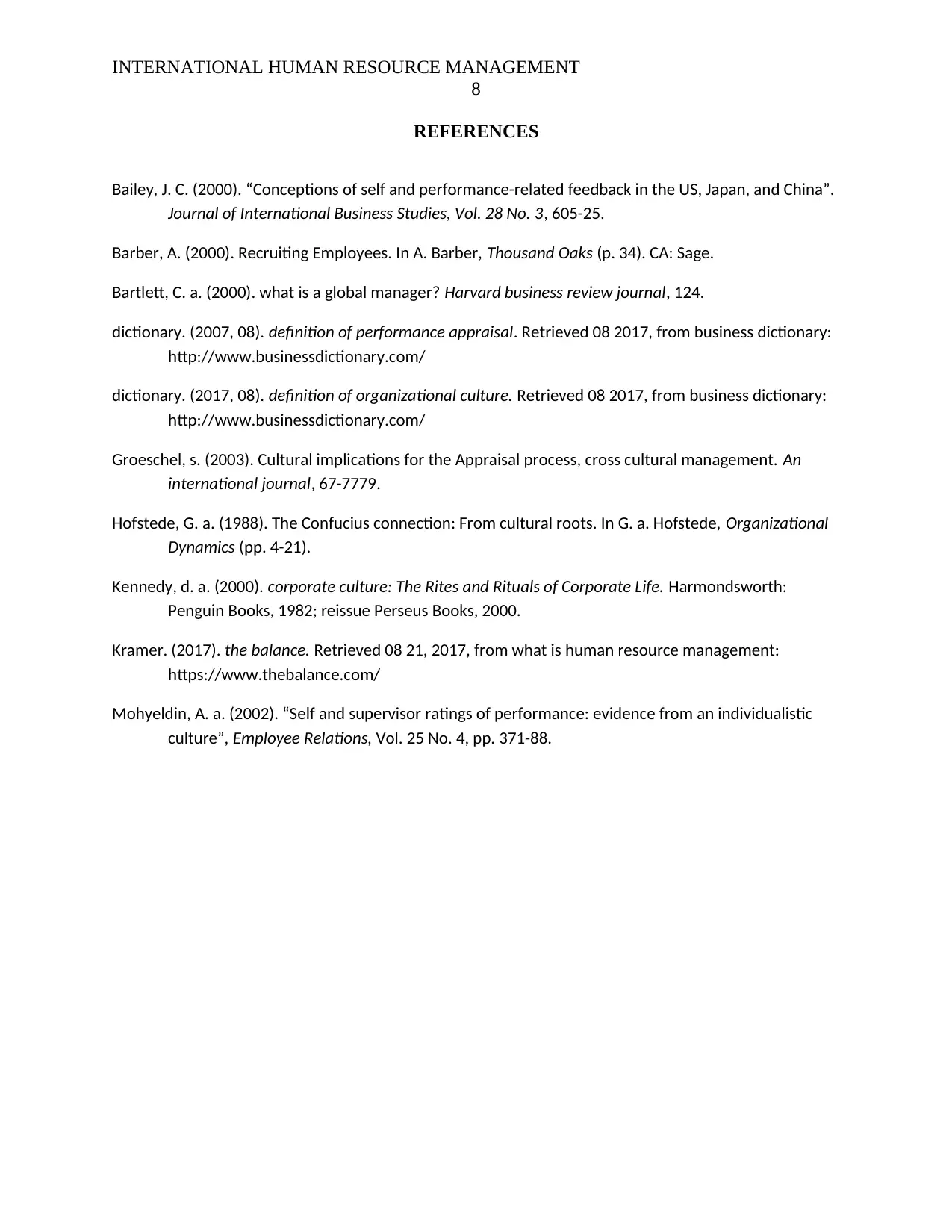
INTERNATIONAL HUMAN RESOURCE MANAGEMENT
8
REFERENCES
Bailey, J. C. (2000). “Conceptions of self and performance-related feedback in the US, Japan, and China”.
Journal of International Business Studies, Vol. 28 No. 3, 605-25.
Barber, A. (2000). Recruiting Employees. In A. Barber, Thousand Oaks (p. 34). CA: Sage.
Bartlett, C. a. (2000). what is a global manager? Harvard business review journal, 124.
dictionary. (2007, 08). definition of performance appraisal. Retrieved 08 2017, from business dictionary:
http://www.businessdictionary.com/
dictionary. (2017, 08). definition of organizational culture. Retrieved 08 2017, from business dictionary:
http://www.businessdictionary.com/
Groeschel, s. (2003). Cultural implications for the Appraisal process, cross cultural management. An
international journal, 67-7779.
Hofstede, G. a. (1988). The Confucius connection: From cultural roots. In G. a. Hofstede, Organizational
Dynamics (pp. 4-21).
Kennedy, d. a. (2000). corporate culture: The Rites and Rituals of Corporate Life. Harmondsworth:
Penguin Books, 1982; reissue Perseus Books, 2000.
Kramer. (2017). the balance. Retrieved 08 21, 2017, from what is human resource management:
https://www.thebalance.com/
Mohyeldin, A. a. (2002). “Self and supervisor ratings of performance: evidence from an individualistic
culture”, Employee Relations, Vol. 25 No. 4, pp. 371-88.
8
REFERENCES
Bailey, J. C. (2000). “Conceptions of self and performance-related feedback in the US, Japan, and China”.
Journal of International Business Studies, Vol. 28 No. 3, 605-25.
Barber, A. (2000). Recruiting Employees. In A. Barber, Thousand Oaks (p. 34). CA: Sage.
Bartlett, C. a. (2000). what is a global manager? Harvard business review journal, 124.
dictionary. (2007, 08). definition of performance appraisal. Retrieved 08 2017, from business dictionary:
http://www.businessdictionary.com/
dictionary. (2017, 08). definition of organizational culture. Retrieved 08 2017, from business dictionary:
http://www.businessdictionary.com/
Groeschel, s. (2003). Cultural implications for the Appraisal process, cross cultural management. An
international journal, 67-7779.
Hofstede, G. a. (1988). The Confucius connection: From cultural roots. In G. a. Hofstede, Organizational
Dynamics (pp. 4-21).
Kennedy, d. a. (2000). corporate culture: The Rites and Rituals of Corporate Life. Harmondsworth:
Penguin Books, 1982; reissue Perseus Books, 2000.
Kramer. (2017). the balance. Retrieved 08 21, 2017, from what is human resource management:
https://www.thebalance.com/
Mohyeldin, A. a. (2002). “Self and supervisor ratings of performance: evidence from an individualistic
culture”, Employee Relations, Vol. 25 No. 4, pp. 371-88.
1 out of 8
Related Documents
Your All-in-One AI-Powered Toolkit for Academic Success.
+13062052269
info@desklib.com
Available 24*7 on WhatsApp / Email
![[object Object]](/_next/static/media/star-bottom.7253800d.svg)
Unlock your academic potential
Copyright © 2020–2025 A2Z Services. All Rights Reserved. Developed and managed by ZUCOL.





